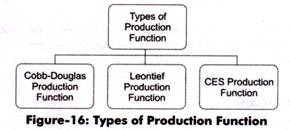Production function is the mathematical representation of relationship between physical inputs and physical outputs of an organization.
There are different types of production functions that can be classified according to the degree of substitution of one input by the other.
Figure-16 shows different types of production function:
The different types of production function (as shown in Figure-16).
1. Cobb-Douglas Production Function:
Cobb-Douglas production function refers to the production function in which one input can be substituted by other but to a limited extent. For example, capital and labor can be used as a substitute of each other, but to a limited extent only.
Cobb-Douglas production function can be expressed as follows:
Q = AKaLb
Where, A = positive constant
ADVERTISEMENTS:
a and b = positive fractions
b = 1 – a
Therefore, Cobb- Douglas production function can also be expressed as follows:
Q = akaL1-a
ADVERTISEMENTS:
The characteristics of Cobb- Douglas production function are as follows:
i. Makes it possible to change the algebraic form in log linear form, represented as follows:
log Q = log A + a log K + b log L
This production function has been estimated with the help of linear regression analysis.
ii. Makes it possible to change the algebraic form in log linear form, represented as follows:
log Q = log A + a log K + b log L
This production function has been estimated with the help of linear regression analysis.
iii. Acts as a homogeneous production function, whose degree can be calculated by the value obtained after adding values of a and b. If the resultant value of a + b is 1, it implies that the degree of homogeneity is 1 and indicates the constant returns to scale.
iv. Makes use of parameters a and b, which signifies the elasticity’ coefficients of output for inputs, labor and capital, respectively. Output elasticity coefficient refers to the change produced in output due to change in capital while keeping labor at constant.
ADVERTISEMENTS:
v. Represents that there would be no production at zero cost.
2. Leontief Production Function:
Leontief production function uses fixed proportion of inputs having no substitutability between them. It is regarded as the limiting case for constant elasticity of substitution.
The production function can be expressed as follows:
q= min (z1/a, Z2/b)
ADVERTISEMENTS:
Where, q = quantity of output produced
Z1 = utilized quantity of input 1
Z2 = utilized quantity of input 2
a and b = constants
ADVERTISEMENTS:
For example, tyres and steering wheels are used for producing cars. In such case, the production function can be as follows:
Q = min (z1/a, Z2/b)
Q = min (number of tyres used, number of steering used).
3. CES Production Function:
CES stands for constant elasticity substitution. CES production function shows a constant change produced in the output due to change in input of production.
It can be represented as follows:
Q = A [aKβ + (1-a) L-β]-1/β
ADVERTISEMENTS:
Or,
Q = A [aL-β + (1-a) K-β]-1/β
CES has the homogeneity degree of 1 that implies that output would be increased with the increase in inputs. For example, labor and capital has increased by constant factor m.
In such a case, production function can be represented as follows:
Q’ = A [a (mK)-β + (1-a) (mL)-β]-1/β
Q’ = A [m-β {aK-β + (1-a) L-β}]-1/β
ADVERTISEMENTS:
Q’ = (m-β)-1/β .A [aK-β + (1-a) L-β)-1/β
Because, Q = A [aK-β + (1-a) L-β]-1/β
Therefore, Q’ = mQ
This implies that CES production function is homogeneous with degree one.
